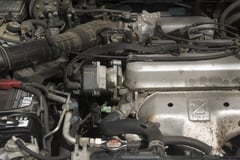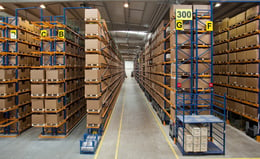Is It Possible to Future-Proof Your Supply Chain?
Brian Hoey - December 17, 2020

 The needs of the future vs. the present can be incredibly tricky to balance. As an example, 90% of supply chain professionals say that AI will have transformed supply chains for the better by 2025—but more 80% of those same professionals say they’ve been frustrated by decisions powered by AI at some point over the course of the pandemic. In other words, almost everyone is looking to adopt this technology in order to power future improvements—but at the present moment that technology may not be adding value. To what extent should you prioritize future value over today’s supply chain success?
The needs of the future vs. the present can be incredibly tricky to balance. As an example, 90% of supply chain professionals say that AI will have transformed supply chains for the better by 2025—but more 80% of those same professionals say they’ve been frustrated by decisions powered by AI at some point over the course of the pandemic. In other words, almost everyone is looking to adopt this technology in order to power future improvements—but at the present moment that technology may not be adding value. To what extent should you prioritize future value over today’s supply chain success?
There’s a formula for answering this question when it comes to something like making a trade in baseball—but for supply chain management there are no easy answers. Given the volatility of the global supply chain in 2020, you want to avoid investments that won’t offer ROI in the near future. Thus, rather than making tradeoffs between present and future success, you need to prioritize future-proofing your supply chain. It can be done—and it begins with these basic steps.
Audit Legacy Technology/ Transition to the Cloud
To truly future-proof a system, you want to move away from software solutions and other technology that run the risk of becoming outdated. Sure, no one deploys an on-prem solution with the expectation that the software will still be in use long after the vendor has stopped making security updates and bug fixes—but in point of fact that happens all the time. And once your software has entered the realm of legacy technology, it tends to become harder and harder to integrate it with other technologies and workflows—such that you eventually wind up with data and planning silos that are difficult to bridge.
Not all legacy technology needs to be gotten rid of, of course—but as you audit your existing technology, it’s important to consider whether any legacy apps you may be using could be migrated to the cloud or replaced with a cloud-based solution. Cloud-based solutions don’t have the same risk of deprecation—or the same risk of running outdated hardware, etc.—that you see with on-prem deployments, which makes them good fits for a future-proofing mindset.
Avoid Single-Sourcing
It’s a story that everyone has heard multiple times by now, but it bears repeating: many of the worst disruptions we saw during the beginning of the pandemic were due to poor visibility and widespread single-sourcing. When it comes to future-proofing your supply chain, strong and diverse supplier relationships are the only way to prevent situations where your entire operation is idle because of the impossibility of getting crucial raw materials. While leanness is an admirable goal, true resilience to future changes comes from the ability to keep multiple options open and choose the optimal one based on the latest conditions and requirements—you simply can’t do that if at a crucial stage in the value stream you have only one option.
Boost Agility Through AI Implementation
Speaking of keeping your options open and choosing the optimal one: Once you’ve transitioned some of your technology stack to the cloud, it should be pretty straightforward to drive towards some amount of AI integration. From there, you can begin to take a smarter, more proactive approach to administering the entire supply chain. With AI-powered demand forecasts, for instance, you can more accurately predict future orders, which in turn enables you to improve your S&OP process, your demand-capacity planning, and even your transportation planning (since you can theoretically book freight for orders that have only been projected). More than that, they give you the power to optimize your production and transport networks in such a way as to reduce waste. All told, the impact here is that you can cut out wasteful spending and reduce capital commitments (e.g. by optimizing your buffer stock based on your analytics), freeing up cash that can be valuable for fighting disruptions and maintaining flexibility further down the line.
Automate
If we focus our attention solely on the past year, the pandemic has certainly been the factor associated with the most disruption in the supply chain. But if we zoom out to consider the past several years, we can start to see how the trends and technologies associated with Industry 4.0 were already changing the way that we do business. On a fundamental level, future-proofing the supply chain is about understanding the likely future of said supply chain—which is one likely to be dominated by the paradigms of the Fourth Industrial Revolution. We’ve already spoken about cloud computing and AI integration—but what about automation? By working proactively to automate processes that can be automated, you do more than just set yourself up for time and cost savings—you also meaningfully further your digital transformation by integrating formerly physical processes into computer-driven simulations and planning flows. This gives you the power to increase the visibility and efficiency of processes that would have previously been resistant to analytics-based workflows. Thus, you gain both process improvements and improved visibility, and you position yourself to tackle changing conditions with ease.
Focus on Sustainability
Now, let’s zoom out even further: it’s going to be imperative for supply chains to adopt smart Industry 4.0 technology in the coming years—but it’s going to be even more imperative that they begin to take carbon emissions and other climate-related factors into account. Many industry leaders are already focusing their attention on ways to track and potentially reduce carbon emissions—and many more expect that government regulations will eventually require them to do so. This means that business across the supply chain will not only need to be able to track sustainability efforts, they’ll also need to be able to factor things like carbon emissions and offsets into the parameters of their planning processes. You need to use the same analytics processes we’ve been discussing above to optimize your emissions against your other supply chain goals and parameters, calculate things like carbon taxes in your cost-benefit analyses, etc. Most planning solutions out there simply aren’t built to handle these sorts of parameters—but if you can find one that is, you’ll be well positioned to tackle these new challenges.
LATEST POSTS
- Understand Why Production Planning Needs Specialized Solutions
- Understand Circular Economy in The Manufacturing Industry
- How Can Industry 4.0 IT Integration Be Achieved Smoothly?
- The Significance of Order Sequencing in Discrete Manufacturing
- How to improve your Supply Chain Management: The Power of Control Towers



